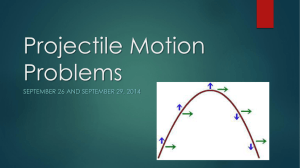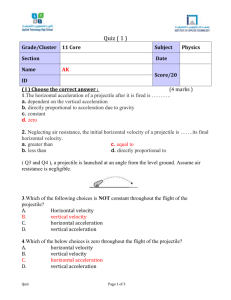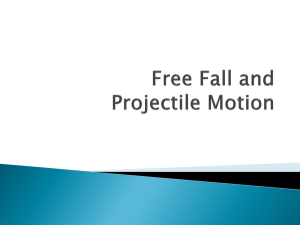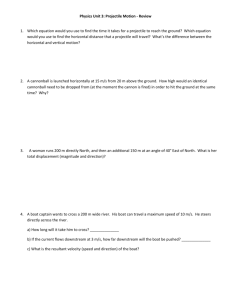ProjectilesMult
advertisement
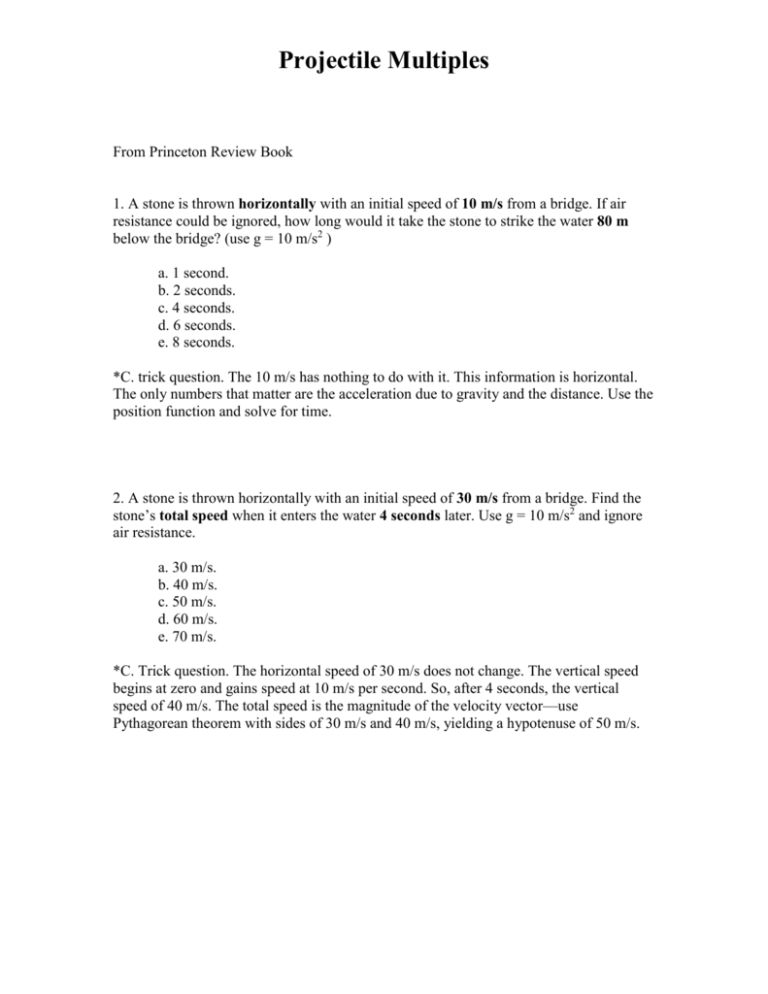
Projectile Multiples From Princeton Review Book 1. A stone is thrown horizontally with an initial speed of 10 m/s from a bridge. If air resistance could be ignored, how long would it take the stone to strike the water 80 m below the bridge? (use g = 10 m/s2 ) a. 1 second. b. 2 seconds. c. 4 seconds. d. 6 seconds. e. 8 seconds. *C. trick question. The 10 m/s has nothing to do with it. This information is horizontal. The only numbers that matter are the acceleration due to gravity and the distance. Use the position function and solve for time. 2. A stone is thrown horizontally with an initial speed of 30 m/s from a bridge. Find the stone’s total speed when it enters the water 4 seconds later. Use g = 10 m/s2 and ignore air resistance. a. 30 m/s. b. 40 m/s. c. 50 m/s. d. 60 m/s. e. 70 m/s. *C. Trick question. The horizontal speed of 30 m/s does not change. The vertical speed begins at zero and gains speed at 10 m/s per second. So, after 4 seconds, the vertical speed of 40 m/s. The total speed is the magnitude of the velocity vector—use Pythagorean theorem with sides of 30 m/s and 40 m/s, yielding a hypotenuse of 50 m/s. 3. Which one of the following statements is true concerning the motion of a projectile launched at an angle of 45 degrees to the horizontal? a. The acceleration vector points opposite the velocity vector on the way up and in the same direction as the velocity vector on the way down. b. The speed at the top of the trajectory is zero. c. The object’s total speed remains constant during the entire flight. d. The horizontal speed decreases on the way up and increases on the way down. e. The vertical speed decreases on the way up and increases on the way down. *e. A is not true—the acceleration vector is only opposite the vertical velocity, but it is not opposite the total velocity vector. B Is not true—only the horizontal speed is zero at the top! C is not true—since the vertical speed is changing, the total velocity is changing. D is not true—horizontal speed is constant. From Old AP’s 4. A 2 kg block rests at the edge of a platform that is 10 meters above level ground. The block is launched horizontally from the edge of the platform with an initial speed of 3 m/s. Air resistance is negligible. The time it will take for the block to reach the ground is most nearly. (remember most nearly means use g = 10 m/s2) a. 0.3 s. b. 1.0 s. c. 1.4 s. d. 2.0 s. e. 3.0 s. * C. The additional horizontal motion of the projectile has no effect on its vertical motion. So, we just need to find the freely fall 10 meters. The 3 m/s is irrelevant. d 12 at 2 10m 12 (10m / s 2 )t 2 t 2 1.41sec 5. A diver initially moving horizontally with speed V dives off the edge of a vertical cliff and lands in the water a distance d from the base of the cliff. How far from the base of the cliff would the diver have landed if the diver initially had been moving horizontally with speed 2V? a. d. b. 2d c. 2d. d. 4d. e. It cannot be determined unless the height of the cliff is known. *C. The time to fall is the same in both cases since the height of the cliff has not changed. Thus, if the horizontal speed is doubled, it will travel twice as far in the same time. 6. A projectile is fired with initial velocity Vo at an angle o with the horizontal and follows the trajectory shown above. Which of the following pairs of graphs best represents the vertical components of the velocity and acceleration, V and a, respectively, of the projectile as a function of time t? a. b. c. d. e. * D. The velocity starts at maximum positive, decreases linearly through zero at the peak and then become negative as the projectile heads back to earth. The acceleration is constant and negative (-9.8 m/s2). 7. A projectile is fired from the surface of the Earth with a speed of 200 m/s at an angle of 30 degrees above the horizontal. If the ground is level, what is the maximum height reached by the projectile? a. 5 meters. b. 10 meters. c. 500 meters. d. 1,000 meters. e. 2,000 meters. * C. The only factors that determine max. height are vertical velocity and gravity. Calculate Vy VoSin (200m/s)si n(30) 100 m/s We don' t care how long it takes to get to peak, so use DKDC : V 2 V02 2a (Y Y0 ) 0 (100m / s ) 2 2(9.8m / s 2 )(Y 0) Y 510m 8. A rock is dropped from the top of a 45 meter tower, and at the same time a ball is thrown from the top of the tower in a horizontal direction. Air resistance is negligible. The ball and the rock hit the level ground a distance of 30 meters apart. The horizontal velocity of the ball thrown was most nearly. (most nearly means g = 10) a. 5 m/s. b. 10 m/s. c. 14.1 m/s. d. 20 m/s. e. 28.3 m/s * B. The rocked that is dropped is a little bit of a red herring. It will fall straight down, so the problem is really telling you that the second rock lands 30 meters from the base of the cliff. You must break the problem into horizontal and vertical information: Vertical : d 12 at 2 45 12 (10)t 2 t 3seconds Horizontal : d vt (30m) Vx (3 sec) Vx 10m / s 9. (1974) A projectile has an initial velocity of magnitude Vo which makes an angle o with the horizontal. Neglecting air friction, all of the following are true at point P, the highest point of its trajectory EXCEPT: a. The time t required to reach P is given by: t = (Vo coso)/g b. The horizontal displacement has been (Vo( coso) t), where t is the time require to reach point P. c. hmax = (Vosin o)2/2g d. The speed is Vo cos o. e. The acceleration is g. *A. A is not true. Time to reach max height has to do with VERTICAL velocity Component which is Vosin. B is true. Horizontal speed is constant d = vt C is true. To prove, apply Don’t Know Don’t Care in vertical direction D is true. At the peak it only has horizontal speed. E is true. In free fall. 10. (1993) A spring-loaded gun can fire a projectile to a height h if it is fired straight up. If the same gun is pointed at an angle of 45 degrees from the vertical, what maximum height can now be reached by the projectile? a. h 4 b. c. h 2 d. h 2 2 h 2 e. h *C. This one is a little tricky. First, you need to find the launching speed of the gun. Then, you need to use this speed and vector breakdown to determine the new maximum speed. We don’t really care how long it takes to get to the maximum height, so use DKDC: V 2 V02 2a (Y Y0 ) 0 V02 2( g )( h 0) V0 2 gh Careful - -you must supply the negative sign for " g". So this is the launch speed of the gun. Now, take this informatio n and apply it to the projectile problem. Vy V0 sin( ) Max. height only applies to vertical informatio n - -you must break it down!! Vy gh sin( 45) 2 gh ( 2 ) gh 2 Now, apply Don' t know Don' t Care again to find max height. 0 - ( gh ) 2 2( g )(Ymax 0) Ymax h / 2 Note: if you are doing this problem in review for the AP, you could also use conservation of energy to find the speeds. 11. (1984) An object slides off a roof 10 meters above the ground with an initial horizontal speed of 5 m/s as shown below. The time between the object’s leaving the roof and hitting the ground is most nearly: a. ½ second b. c. 1 2 s 2 s d. 2 s e. 5 2 s *C. The AP folks are making sure that you know which pieces of information are relevant. The only things that affect the time in the air are vertical height, vertical speed, and vertical acceleration due to gravity. The 5 m/s has no affect on this question. d 12 at 2 10m 12 (10m / s 2 )t 2 so.... t 2 12. A ball is thrown and follows the parabolic path shown above. Air friction is negligible. Point Q is the highest point on the path. Points P and R are the same height above the ground. How do the speeds of the ball at the three points compare? a. VP < VQ < VR b. VR < VQ < VP c. VQ < VR < VP d. VQ < VP = VR e. VP = VR < VQ *D. By symmetry, the speeds at P and R are the same. The speed at Q is the minimum speed since at this point the projectile only has its initial horizontal speed. 13. (2004, 39%) An object is thrown with velocity V from the edge of a cliff above level ground. Neglect air resistance. In order for the object to travel a maximum horizontal distance from the cliff before hitting the ground, the throw should be at an angle with respect to the horizontal of: a. greater than 60 degrees above the horizontal. b. greater than 45 degrees but less than 60 degrees above the horizontal. c. greater than zero but less than 45 degrees above the horizontal. d. zero. e. greater than zero but less than 45 degrees below the horizontal. * On level ground, the angle that yields maximum range is 45 degrees. Since the projectile has a little bit of initial height, it will spend a little more time in the air and does not need as much vertical motion as it would on level ground, so you can redirect the velocity a little bit lower than 45 degrees. Questions 10 and 11: 10. (1993) Which of the following vectors best indicates the direction of the acceleration, if any, of the ball at point Q? a. b. c. d. e. There is no acceleration of the ball at point Q. * C. A very common misconception is that the acceleration of a projectile is zero at the peak. Only the VERTICAL VELOCITY is zero at the peak. The Earth is still pulling on the projectile. If the acceleration were zero, the velocity could never change and the projectile would continue off horizontally forever. 11. Which of the following vectors best indicates the direction of the net force on the ball at point P? a. b. c. d. e. * D. The net force on the ball is the weight of the ball, which is directed toward the center of the Earth or downward. If you chose “A” you were thinking of the inertia of the ball, which is not a force. If you chose “E” you were thinking of air resistance. I have no idea what you were thinking about if you chose “B” or “C”.



